
Kilpeck is a village and civil parish in the county of Herefordshire, England. It is about nine miles (14 km) southwest of Hereford, just south of the A465 road and Welsh Marches Line to Abergavenny, and about five miles (8 km) from the border with Wales. On 1 April 2019 the parishes of Kenderchurch, St Devereux, Treville and Wormbridge were merged with Kilpeck.

Stowe is a civil parish and former village about two miles northwest of Buckingham in the unitary authority area of Buckinghamshire, England. The parish includes the hamlets of Boycott, Dadford and Lamport.
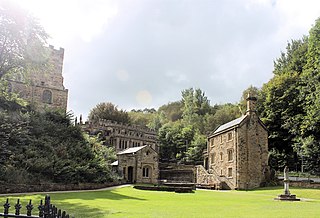
Holywell is a market town and community in Flintshire, Wales. It lies to the west of the estuary of the River Dee. The community includes Greenfield. In 2011 it had a population of 8886.

St Winefride's Well is a holy well and national shrine located in the Welsh town of Holywell in Flintshire. The patron saint of the well, St Winefride, was a 7th-century Catholic martyr who according to legend was decapitated by a lustful prince and then miraculously restored to life. The well is said to have sprung up at the spot where her head hit the ground. This story is first recorded in the 12th century, and since then St Winefride's Well has been a popular pilgrimage destination, known for its healing waters. The well is unique among Britain's sacred sites in that it retained a continuous pilgrimage tradition throughout the English Reformation.

The Diocese of Saint Asaph is a diocese of the Church in Wales in north-east Wales, named after Saint Asaph, its second bishop.

Warboys is a large village and civil parish in the Huntingdonshire district of Cambridgeshire, England, 7 miles (11 km) north-east of Huntingdon.
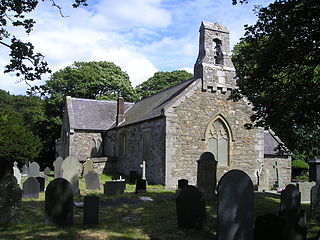
Llanrhos is a village in the community of Conwy, in Conwy County Borough, Wales. The village lies between the towns of Conwy and Llandudno. Llanrhos was a civil parish from 1894 until 1974. The area was formerly part of a larger parish called Eglwys Rhos or Eglwysrhos, being an old variant name for the same village. The ancient parish included Deganwy, the Craig-y-Don district of Llandudno, the Little Orme and Penrhyn Bay. The area was in the administrative county of Caernarfonshire prior to 1974.
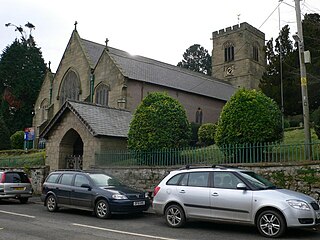
Whitford is a village, community and an electoral ward near Holywell in Flintshire, northeast Wales. The population of both the community and the ward taken at the 2011 census was 2,332. The community includes the villages of Carmel, Lloc, Gorsedd and Pantasaph.
Mostyn Colliery was a coal mine in Flintshire, North Wales, that was owned in the later part of its operating life by the influential Mostyn family. The colliery was located at Mostyn on the banks of the River Dee.

Swimbridge is a village, parish and former manor in Devon, England. It is situated 4 miles (6.4 km) south-east of Barnstaple and twinned with the town of St.Honorine Du Fay in Normandy, France. It was the home of the Rev. John "Jack" Russell who first bred the Jack Russell Terrier.
Ewyas was a possible early Welsh kingdom which may have been formed around the time of the Roman withdrawal from Britain in the 5th century. The name was later used for a much smaller commote or administrative sub-division, which covered the area of the modern Vale of Ewyas and a larger area to the east including the villages of Ewyas Harold and Ewyas Lacy.
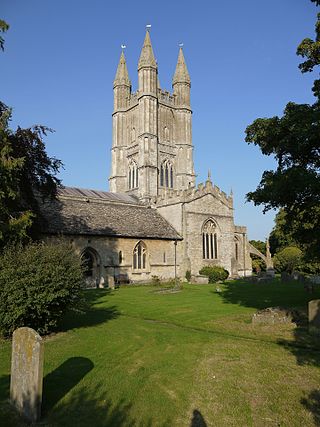
St Sampson's is the Church of England parish church of the town of Cricklade, Wiltshire, England. A large aisled church with a central tower, the present building dates from the late 12th century but has fragments of Anglo-Saxon work. The church is a Grade I listed building.

Chesterton is a village and civil parish on Gagle Brook, a tributary of the Langford Brook in north Oxfordshire. The village is about 1+1⁄2 miles (2.4 km) southwest of the market town of Bicester. The village has sometimes been called Great Chesterton to distinguish it from the hamlet of Little Chesterton, about 3⁄4 mile (1.2 km) to the south in the same parish. The 2011 Census recorded the parish population as 850.
Piers Griffith (1568–1628) was a Welsh pirate.

St Beuno's Church, Trefdraeth is the medieval parish church of Trefdraeth, a hamlet in Anglesey, north Wales. Although one 19th-century historian recorded that the first church on this location was reportedly established in about 616, no part of any 7th-century structure survives; the oldest parts of the present building date are from the 13th century. Alterations were made in subsequent centuries, but few of them during the 19th century, a time when many other churches in Anglesey were rebuilt or were restored.

St Beuno's Church, Aberffraw is a 12th-century parish church in Anglesey, north Wales. A church was established in Aberffraw in the 7th century by St Beuno, who became the abbot of Clynnog Fawr, Gwynedd. St Beuno's may have been used as a royal chapel during the early Middle Ages, as the princes of Gwynedd had a court in Aberffraw. The oldest parts of the church date from the 12th century, although it was considerably enlarged in the 16th century when a second nave was built alongside the existing structure, with the wall in between replaced by an arcade of four arches. Restoration work in 1840 uncovered a 12th-century arch in the west wall, which may have been the original chancel arch or a doorway to a western tower that has been lost. The church also has a 13th-century font, some memorials from the 18th century, and two 18th-century copper collecting shovels.

The Church of St Mary the Virgin is situated in Beighton, a suburb of the City of Sheffield, England. It is located just off High Street, it is the parish church for the parish of Beighton and a Grade II* listed building. Although the original church dated from the 12th century there is no remaining trace of this original structure, although there are some later Medieval parts. It is dedicated to Mary, the mother of Jesus. The benefice is currently vacant.

Saint Aelhaiarn or Aelhaearn was a Welsh confessor and saint of the British Church. He was a disciple of Saint Beuno. His feast day was usually observed on 2 November, although it is sometimes recorded as the 1st and is no longer observed by either the Anglican or Catholic church in Wales.

St Beuno’s Church is the parish church of Berriew, in the historic county of Montgomeryshire, now Powys. The church stands in an almost oval churchyard in the centre of the village. The original church was a single-chamber, with a wooden west bellcote and a northchancel chapel. This church was replaced in 1803-4 with a larger brick church by the architect John Hiram Haycock of Shrewsbury. It was of brick with stone dressings, and had the entry under a pinnacled west tower to a galleried nave with four round-headed windows a side. The church was largely rebuilt by his grandson, Edward Haycock, Junior in 1876. It consists of a nave, aisles, chancel, north porch, and west tower The west tower has the doorway blocked, stone facing for brick, and Gothic windows, except for the circular ones on its second stage.
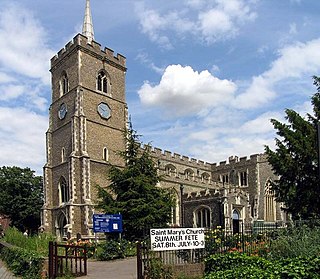
St Mary's Church is a grade I listed parish church in Ware, Hertfordshire, England.


















